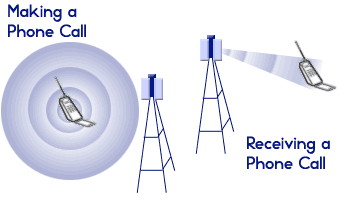
Wireless telephones are hand-held phones with built-in antennas, often called cell, mobile, or PCS phones. These phones are popular with callers because they can be carried easily from place to place. Wireless telephones are two-way radios. When you talk into a wireless
telephone, it picks up your voice and converts the sound to radiofrequency
energy (or radio waves). The radio waves travel through the air
until they reach a receiver at a nearby base station. The base station
then sends your call through the telephone network until it reaches
the person you are calling. When you receive a call on your wireless telephone, the message travels through the telephone network until it reaches a base station close to your wireless phone. Then the base station sends out radio waves that are detected by a receiver in your telephone, where the signals are changed back into the sound of a voice. The Federal Communications Commission (FCC) and the Food and Drug Administration (FDA) each regulate wireless telephones. FCC ensures that all wireless phones sold in the United States follow safety guidelines that limit radiofrequency (RF) energy. FDA monitors the health effects of wireless telephones. Each agency has the authority to take action if a wireless phone produces hazardous levels of RF energy. FDA derives its authority to regulate wireless telephones from the Radiation Control provisions of the Federal Food, Drug, and Cosmetic Act (originally enacted as the Radiation Control for Health and Safety Act of 1968). [http://www.fda.gov/cdrh/comp/eprc.html]. FCC derives its authority to regulate wireless telephones from the National Environmental Policy Act of 1969 (NEPA) and the Telecommunications Act of 1996 [http://www.fcc.gov/telecom.html].
|
|||
